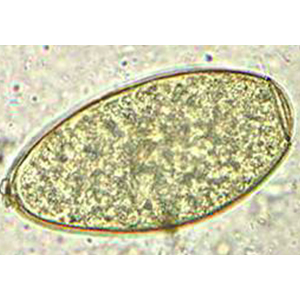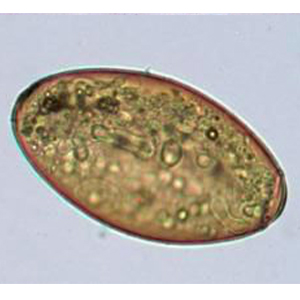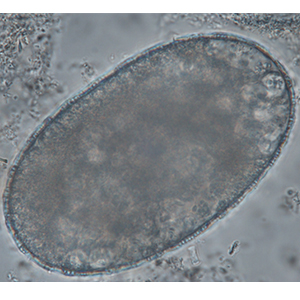Fasciola hepatica is a trematode of the Fasciolidae family. It affects the hepatic parenchyma and biliary tract of many different species of domestic and wild animals (ruminants, equids, leporids, marsupials, primates) and is transmissible to humans (Robinson & Dalton, 2009).
Epidemiology
Fasciola hepatica is a cosmopolitan parasite described mostly in Old-World Monkeys (Robinson & Dalton, 2009) but can also affect some New World Monkeys like marmosets (Mendes et al., 2008).
Description
Fasciola hepatica eggs are operculated and large (130-140 µm long and 80-85 µm large). Their content is granulomatous (Garcia, 2021).
Differential diagnosis
Differential diagnosis includes other trematode eggs of non-human primates, namely those belonging to Gastrodiscoides hominis and Fasciolopsis buski, as well as mite eggs. Indeed, eggs from Gastrodiscoides hominis and Fasciolopsis buski cannot be differentiated from those of Fasciola hepatica by ovodiagnosis. Differentiation requires larva visualization after coproculture (Garcia, 2021). Mite eggs are of similar dimensions as trematode eggs. They are easy to identify when mature as embryos are clearly visible (Petithory et al., 1995). However, differentiation is more difficult when the egg is immature.
Clinical significance
Clinical description of fasciolosis is rare in non-human primates. In humans, it can cause abdominal pain, digestive symptoms like diarrhea and vomiting, hyperthermia, hepatomegaly and eosinophilia in acute phase. During the more chronic phase of the disease, symptoms like lethargy and weight loss can occur due to the presence of adult parasites in bile ducts but are rare. Extra-hepatic parasitosis has also been described (Global Health, Division of Parasitic Diseases and Malaria, 2019c).
Prophylaxis and treatment
As Fasciola hepatica is zoonotic, hygienic measures need to be taken in case of diagnosis, notably due to the fact that environmental treatment can prevent the development of the parasite by blocking its life cycle.
In humans and animals, triclabendazole is used to treat Fasciola hepatica infections. It can be combined with artesunate or artemether if necessary (Duthaler et al., 2010). Trematode infections can also be treated with 15-40 mg/kg of praziquantel in primates (Calle & Joslin, 2015).
Zoonotic transmission of this parasite does not occur in zoological park, as human contamination requires the ingestion of fresh aquatic plants on which the metacercarial forms of the parasite reside.






